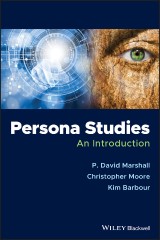Details

Persona Studies
An Introduction1. Aufl.
|
26,99 € |
|
| Verlag: | Wiley-Blackwell |
| Format: | |
| Veröffentl.: | 15.03.2019 |
| ISBN/EAN: | 9781118935064 |
| Sprache: | englisch |
| Anzahl Seiten: | 272 |
DRM-geschütztes eBook, Sie benötigen z.B. Adobe Digital Editions und eine Adobe ID zum Lesen.
Beschreibungen
<p><b>The definitive and first major text on personas in contemporary culture</b></p> <p>Modern social media and communication technologies have reshaped our identities and transformed contemporary culture, revealing an expanded and intensified reforming of our collective online behavior. Billions of people worldwide are increasingly engaged in the production, presentation, and modification of their public selves—curating personas through various social media and fundamentally altering how we interact in the twenty-first century. The study of persona is essential to understanding contemporary culture, yet literature in this emerging field is scarce. Filling a gap in current knowledge, <i>Persona Studies: An Introduction </i>is the first major work to examine the construction, delivery, and curation of public identities in contemporary online culture. </p> <p>This timely book helps readers navigate the changing cultural landscape while laying the groundwork for further research and application of persona studies. Three case studies are included—examining personas of the artist, gamer, and professional—to illustrate how personas continue to transform identity and reshape contemporary culture. From the historical precursors of the current iteration of persona to emerging configurations of public self, this unique work offers readers a broad introduction to the evolving theories and concepts of how persona defines the contemporary condition and its relation to technology and collective identity. To summarize, the book:</p> <ul> <li>Analyzes how identities linked to data are cultivated, curated and mined for various purposes</li> <li>Discusses the mediated blending of media and different types of interpersonal communication</li> <li>Explores tools for the investigation and analysis of persona, including Prosopographic field studies and information visualization</li> <li>Translates new research, concept, theories, methods, and approaches into clear case studies and applications</li> <li>Examines the personalization of public, private, and intimate information in the building of new personas</li> </ul> <p><i>Persona Studies: An Introduction</i> is an innovative resource for students, academics, researchers, and professionals in fields covering digital and social media, technology and culture, mass media and communications, social and media psychology and sociology, and professional studies.</p>
<p>About the Authors ix</p> <p>Acknowledgments xi</p> <p>Introduction: A Short History of the New Public Self 1</p> <p>References 13</p> <p><b>Part I Conceptualising Persona 15</b></p> <p><b>1 Persona and Its Uses 17</b></p> <p>Persona Studies and the Public Self 18</p> <p>From Personae to Persona 20</p> <p>The Premodern to the Contemporary Self 24</p> <p>Applying Persona 26</p> <p>Persona in Psychology 27</p> <p>Persona in Literature 28</p> <p>Persona in Performing Arts 29</p> <p>Persona as Performance 30</p> <p>Persona Through Personalization 32</p> <p>References 35</p> <p><b>2 The Contemporary Significance of Persona 39</b></p> <p>Introduction 39</p> <p>Intercommunication: The Human–Machine Interface 39</p> <p>Celebrity and Surveillance 42</p> <p>Intercommunication 47</p> <p>Intercommunication and Affect Theory 52</p> <p>Conclusion 54</p> <p>References 55</p> <p><b>3 Intercommunication and the Dimensions and Registers of Persona 59</b></p> <p>Introduction 59</p> <p>Persona as Individualized 60</p> <p>Persona as Interpersonal 61</p> <p>Persona as Indexical 62</p> <p>Persona as Internetworked 63</p> <p>Registers of Performance 65</p> <p>Professional 65</p> <p>Personal 66</p> <p>Intimate 66</p> <p>Five Dimensions of Persona 67</p> <p>Public Dimension of Persona 68</p> <p>Mediatized Dimension of Persona 69</p> <p>Performative Dimension of Persona 69</p> <p>Collective Dimension of Persona 71</p> <p>The Fifth Dimension of Persona: Value, Agency, Reputation, Prestige (VARP) 72</p> <p>Value 74</p> <p>Agency 75</p> <p>Reputation 77</p> <p>Prestige 78</p> <p>Conclusion 79</p> <p>References 80</p> <p><b>4 The Collective Constitution of Public Persona 87</b></p> <p>Micro‐publics 87</p> <p>Microcelebrity 90</p> <p>Surveillance Capitalism and Persuasive Technologies 91</p> <p>Persona as Digital Objects 94</p> <p>Digital Objects, Micro‐publics, and Hyperobjects 96</p> <p>Digital Object and Autosurveillance 99</p> <p>Conclusion 105</p> <p>References 106</p> <p><b>Part II Researching Persona 111</b></p> <p><b>5 Analyzing Contemporary Persona: Methods to Reveal the Public Version of the Self 113</b></p> <p>Researching Ourselves: Reflexivity, Autoethnography, and First‐person Action Research 114</p> <p>Interpreting the Public Self: Interpretative Phenomenological Analysis 115</p> <p>Personas in the Making: Second‐person Action Research 119</p> <p>Reputation and Inter‐related Persona: Prosopographic Field Study 123</p> <p>Networked Selves: Information Visualization and Exploration 126</p> <p>Conclusion 128</p> <p>References 129</p> <p><b>6 The Artist’s Persona 133</b></p> <p>The Artist as Subject 134</p> <p>The Artist Myth 135</p> <p>Romanticism and the Arts 136</p> <p>Self‐presentation in the Myth of the Artist 136</p> <p>Artist’s Typologies 137</p> <p>Authors, Auteurs, and Makers 141</p> <p>The Artist as Creative Laborer 144</p> <p>Online Artistness 145</p> <p>Conclusion 150</p> <p>References 151</p> <p><b>7 From Player to Persona 155</b></p> <p>The Role of Avatars 157</p> <p>From Avatar to Persona 159</p> <p>The Rise and Fall of the Gamer 161</p> <p>Gâmeur: From Modder to Indie Game Developer Persona 165</p> <p>Public 167</p> <p>Mediatized 169</p> <p>Performative 170</p> <p>Collective 171</p> <p>Intentional Value (VARP) 172</p> <p>Conclusion 174</p> <p>References 175</p> <p><b>8 The Professional Persona 179</b></p> <p>Work, Public Identity, and the Concept of the Professional 179</p> <p>Step 1: Identify Online Culture’s Destabilizing Effect on Professional Personas 183</p> <p>Step 2: The Instability of Past Value and the Push to New Value 185</p> <p>Step 3: Agency, Active Visibility, and the Professional Persona 189</p> <p>Step 4: The Online Transformation of Professional Reputation and Prestige 197</p> <p>Conclusion 201</p> <p>References 201</p> <p>Conclusion 205</p> <p>Glossary: Key Words in Persona Studies 221</p> <p>Index 245</p>
<p><b>P. David Marshall</b> is Professor and Personal Research Chair in New Media, Communication and Cultural Studies, Deakin University, Australia.</p> <p><b>Christopher Moore</b> is Senior Lecturer in Digital Communication and Media, University of Wollongong, Australia.</p> <p><b>Kim Barbour</b> is Lecturer in Media, School of Humanities, Faculty of Arts, University of Adelaide, Australia.</p>

















